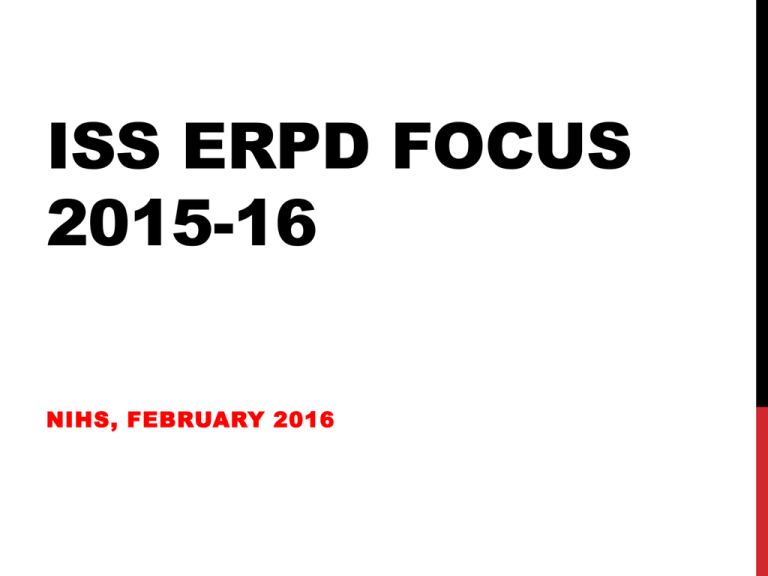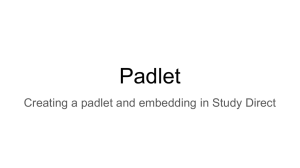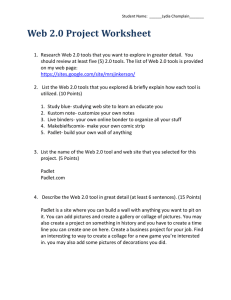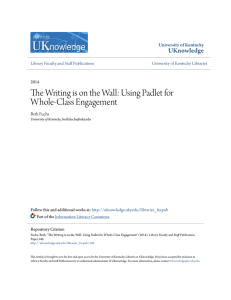ISS ERPD FOCUS 2015-16 NIHS, FEBRUARY 2016
advertisement

ISS ERPD FOCUS 2015-16 NIHS, FEBRUARY 2016 WHAT ARE THE 3 PD AREAS OF FOCUS FOR THE YEAR? Building Relationships Lesson Design Know My Content WHAT ARE THE 3 PD AREAS OF FOCUS FOR THE YEAR? Building Relationships • September: Greet students by name at the door. • October: Give specific praise for the “right” things…feed their growth mindset. • February: Be kind. Discover their story. (data day with Lindsay) Lesson Design • September: Start with a bell-ringer. • October: Teach using Gradual Release…I do, we do, you do. • February: Be intentional about device usage. Notes=no. Assessments=YES!!! (Canvas with Crouch, Schoolnet with Reece) WHAT ARE THE 3 PD AREAS OF FOCUS FOR THE YEAR? Know My Content • September: Activities align to standards; plan with the end in mind. • October: Plan to avoid misconceptions (PLCing). • February: Assess students online, using language they are likely to encounter on exam (today’s vocab with Williams, Canvas with Crouch, Schoolnet with Reece) Additionally, for the past two years, NIHS has done some additional PD on incorporating more literacy in each classroom. It has been one of our SIT goals for the past several years. VOCABULARY STRATEGIES = LITERACY AND ASSESSMENT IMPROVEMENT NIHS ERPD FEBRUARY 2016 DO NOW… • Click the following padlet link for the appropriate session and answer the two questions HONESTLY. • Once you have responded, spend some time reading the posts of your colleagues. This is not a gotcha! 12:45 session: http://padlet.com/natalie_william/omn0u6tq606g 2:25 session: http://padlet.com/natalie_william/fv66860bal7k 3:15 session: http://padlet.com/natalie_william/ttiyp2eaj6oz MARZANO’S SIX STEPS FOR VOCABULARY INSTRUCTION 1. Provide a description, explanation, or example of the new term. 2. Ask students to restate the description, explanation, or example in their own words. 3. Ask students to construct a picture, symbol, or graphic representing the term. 4. Engage students periodically in activities that help them add to their knowledge of terms in their notebooks. 5. Periodically ask students to discuss the terms with one another. 6. Involve students periodically in games that allow them to play with terms. (Remember that it takes 7 times of doing something for it to become habit.) ISS ACADEMIC VOCABULARY LIST Click here for a K-12 list from all academic areas, fine arts, and foreign languages. WHICH WORD DOESN’T BELONG? Give students 4 words or class terms: 3 similar, 1 different. https://kahoot.it Game pin 555238 (Discussion/explanation is crucial for understanding.) KICK ME https://www.teachingchannel.org/videos/making-vocabulary-lesson-interactive This activity is great for practice of the following: • Analogies • Definitions • Real-world examples • Figurative Language VOCABULARY ALIVE • Vocabulary words are assigned to students or groups of students and a gesture or action is chosen to show the meaning of the word. • “The word is _________ (say it and hold up word for class to see) and it looks like ________ .” • Use it like a game of memory by repeating the past speaker’s gesture. INTERACTIVE WORD WALL How to make your Word Wall more interactive: • Mystery Word — add a new word for students to find on a regular basis. Use to start discussion. Great for introducing new topic. • Take a word off wall and rearrange others. Students decide what is missing. You can give clues to help guide. VISUAL VOCABULARY • Go to http://goformative.com/ • Put in the Quick Code: JTDN776 TRIED AND TRUE Click here for graphic organizers to use with vocabulary practice. FLASHCARDS Study Stack: students can play games to master vocab. Study Blue: students can track their mastery of the terms Good ol’ index cards hole-punched (main office) and held together by a clasp ring students can get at Staples, Walmart, etc.




